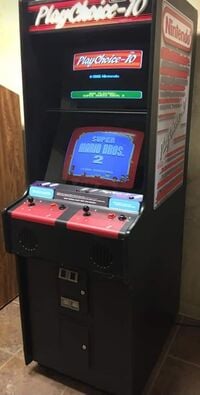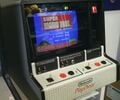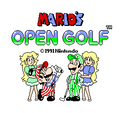Nintendo PlayChoice-10: Difference between revisions
m (Text replacement - "Category:Video Game Systems" to "Category:Video game systems") |
No edit summary |
||
| (29 intermediate revisions by 7 users not shown) | |||
| Line 1: | Line 1: | ||
{{more images}} | {{more images|Nintendo PlayChoice-10 logo}} | ||
{{system | {{system infobox | ||
| | |image=[[File:Nintendo Playchoice-10.jpeg|200px]]<br>''[[Super Mario Bros. 2]]'' in a dual-screen cabinet | ||
| | |release=August 1986<ref>[https://archive.org/details/cashbox50unse_5/page/41/mode/1up Cashbox 1986-08-30]</ref><ref>[https://archive.org/details/cashbox50unse_23/page/n53/mode/1up Cashbox 1987-01-17]</ref> | ||
| | |discontinued=Mid 1992 | ||
| | |predecessor=[[VS. System]] | ||
| | |successor={{wp|Super Nintendo Entertainment System#Casing|Nintendo Super System}} | ||
}} | }} | ||
The '''Nintendo PlayChoice-10''' is an arcade machine that consists of ten different games that had previously | The '''{{wp|Nintendo Entertainment System models#PlayChoice-10|Nintendo PlayChoice-10}}''', or simply the '''PlayChoice-10''', is an arcade machine that consists of ten different games that had previously been available only on the [[Nintendo Entertainment System]] (NES). Players insert coins to play the games included on the Nintendo PlayChoice-10 for an allotted time. The PlayChoice-10 was never released in Japan. | ||
The Nintendo PlayChoice-10 was made in response to home gaming consoles nearing the popularity of arcade machines, so [[Nintendo]] decided to capitalize on this trend by making standup arcade machines out of its existing console systems. Nintendo packed its most popular games, including games of the [[Super Mario (franchise)|''Super Mario'' franchise]], into a machine case and called it the PlayChoice-10. This system served to advertise new NES games, some of which debuted before their {{wp|Western world|Western}} NES release like ''[[Super Mario Bros. 3]]''. | |||
[[ | The machine was compatible with the Nintendo Entertainment System, but it was actually quite different. Instead of using normal NES cartridges, the PlayChoice-10 used special expansion cards containing usually unmodified NES games along with extra 8KB ROM to display hints for dual-screen machines. The PlayChoice-10 output RGB video used a slightly different palette, so games did not look exactly as they would on the NES. Usually, the PlayChoice versions are much more faithful to the NES version when compared to the [[VS. System]] versions, which are usually adjusted to become more difficult. ''[[NES Open Tournament Golf|Mario's Open Golf]]'' is a rare example of a PlayChoice-10 version that has been altered considerably, in this case slimmed down to a few modes. | ||
The machine was compatible with the | |||
The earliest model has dual-screens with the top screen showing the menu, tips, instructions, and remaining playing time. Starting in 1988, Nintendo began selling both dedicated single-screen upright cabinets and conversion kits for older Nintendo cabinets (''[[Donkey Kong (game)|Donkey Kong]]'', ''[[Donkey Kong Jr. (game)|Donkey Kong Jr.]]'', ''{{wp|Popeye (game)|Popeye}}'', and the VS. UniSystem). The dedicated single-screen cabinet is displayed simply as "PlayChoice" and uses the same type of cabinet as the VS. UniSystem but is painted black instead of gray. | |||
The PlayChoice-10 received a [[Super Nintendo Entertainment System]]-based successor called the {{wp|Super Nintendo Entertainment System#Casing|Nintendo Super System}}. | |||
The Nintendo PlayChoice-10 was one of the last arcade machines made by Nintendo before the company announced it would cease production of coin-op equipment in 1992.<ref>[https://archive.org/details/cashbox56unse_0/page/28/mode/1up "Nintendo Will No Longer Produce Coin-Op Equipment"]</ref><ref>[https://archive.org/details/cashbox56unse_1/page/29/mode/1up "Nintendo Stops Games Manufacturing; But Will Continue Supplying Software"]</ref> | |||
==List of ''Super Mario'' games== | |||
Seven titles of the ''Super Mario'' franchise were released for the PlayChoice-10. Comparatively, the Nintendo Super System had only one, ''[[Super Mario World]]''. | |||
*''[[Dr. Mario (game)|Dr. Mario]]'' (1990) | *''[[Dr. Mario (game)|Dr. Mario]]'' (1990) | ||
*''[[Golf]]'' ( | *''[[Golf]]'' (1986) | ||
*''[[Mario Bros. (game)|Mario Bros.]]'' (1986) | *''[[Mario Bros. (game)|Mario Bros.]]'' (1986) | ||
*''[[NES Open Tournament Golf]]'' ( | *''[[NES Open Tournament Golf|Mario's Open Golf]]'' (1992) | ||
*''[[Super Mario Bros.]]'' ( | *''[[Super Mario Bros.]]'' (1986) | ||
*''[[Super Mario Bros. 2]]'' (1988) | *''[[Super Mario Bros. 2]]'' (1988) | ||
*''[[Super Mario Bros. 3]]'' (1989) | *''[[Super Mario Bros. 3]]'' (1989) | ||
==Gallery== | |||
<gallery> | |||
Nintendo PlayChoice cabinet.jpg|''Super Mario Bros. 2'' in a single-screen cabinet | |||
Nintendo PlayChoice CounterTop.jpg|''Super Mario Bros.'' in a PlayChoice CounterTop cabinet | |||
PC-10 Mario's Open Golf - title screen.png|''[[NES Open Tournament Golf|Mario's Open Golf]]'' title screen | |||
FrenchPlay10.jpeg|French PlayChoice-10 flyer showing a Europe-only model by a licensed manufacturer | |||
</gallery> | |||
==References== | ==References== | ||
{{NIWA|NWiki=Nintendo PlayChoice-10}} | |||
<references/> | <references/> | ||
{{Consoles}} | {{Consoles}} | ||
[[Category: | [[Category:Systems]] | ||
[[Category:Reissues]] | [[Category:Reissues]] | ||
Revision as of 05:47, December 13, 2023
It has been requested that more images be uploaded for this article. Remove this notice only after the additional image(s) have been added. Reason: Nintendo PlayChoice-10 logo
| Nintendo PlayChoice-10 | |
|---|---|
 Super Mario Bros. 2 in a dual-screen cabinet | |
| Release date | August 1986[1][2] |
| Discontinued | Mid 1992 |
| Predecessor | VS. System |
| Successor | Nintendo Super System |
The Nintendo PlayChoice-10, or simply the PlayChoice-10, is an arcade machine that consists of ten different games that had previously been available only on the Nintendo Entertainment System (NES). Players insert coins to play the games included on the Nintendo PlayChoice-10 for an allotted time. The PlayChoice-10 was never released in Japan.
The Nintendo PlayChoice-10 was made in response to home gaming consoles nearing the popularity of arcade machines, so Nintendo decided to capitalize on this trend by making standup arcade machines out of its existing console systems. Nintendo packed its most popular games, including games of the Super Mario franchise, into a machine case and called it the PlayChoice-10. This system served to advertise new NES games, some of which debuted before their Western NES release like Super Mario Bros. 3.
The machine was compatible with the Nintendo Entertainment System, but it was actually quite different. Instead of using normal NES cartridges, the PlayChoice-10 used special expansion cards containing usually unmodified NES games along with extra 8KB ROM to display hints for dual-screen machines. The PlayChoice-10 output RGB video used a slightly different palette, so games did not look exactly as they would on the NES. Usually, the PlayChoice versions are much more faithful to the NES version when compared to the VS. System versions, which are usually adjusted to become more difficult. Mario's Open Golf is a rare example of a PlayChoice-10 version that has been altered considerably, in this case slimmed down to a few modes.
The earliest model has dual-screens with the top screen showing the menu, tips, instructions, and remaining playing time. Starting in 1988, Nintendo began selling both dedicated single-screen upright cabinets and conversion kits for older Nintendo cabinets (Donkey Kong, Donkey Kong Jr., Popeye, and the VS. UniSystem). The dedicated single-screen cabinet is displayed simply as "PlayChoice" and uses the same type of cabinet as the VS. UniSystem but is painted black instead of gray.
The PlayChoice-10 received a Super Nintendo Entertainment System-based successor called the Nintendo Super System.
The Nintendo PlayChoice-10 was one of the last arcade machines made by Nintendo before the company announced it would cease production of coin-op equipment in 1992.[3][4]
List of Super Mario games
Seven titles of the Super Mario franchise were released for the PlayChoice-10. Comparatively, the Nintendo Super System had only one, Super Mario World.
- Dr. Mario (1990)
- Golf (1986)
- Mario Bros. (1986)
- Mario's Open Golf (1992)
- Super Mario Bros. (1986)
- Super Mario Bros. 2 (1988)
- Super Mario Bros. 3 (1989)
Gallery
Mario's Open Golf title screen



